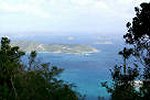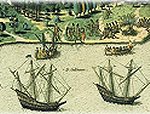| St. John Archeology |
| http://www.sina.com.cn 2004/09/21 14:08 冰岩双语文化工作室 |
语音讲解: EXPLORATIONS – St. John Archeology By Jerilyn Watson Broadcast: July 2, 2003 (THEME) VOICE ONE: This is Nicole Nichols. VOICE TWO:
And this is Steve Ember with the VOA Special English program EXPLORATIONS. Today we tell about discoveries of the past on the island of Saint John, in the United States Virgin Islands. Saint John covers forty-nine square kilometers of land between the Caribbean Sea and the Atlantic Ocean, east of Puerto Rico. (THEME) VOICE ONE: When many people think about the Virgin Islands, they think of a beautiful holiday place with bright sunshine and clear blue seas. But serious science is also taking place on Saint John.
Archeologists have uncovered a ceremonial center near the waters of Saint John’s Cinnamon Bay. A tribal people called the Taino (Tah-EE-no) created the area. The Taino may have used this place for religious purposes hundreds of years ago. Near the ceremonial site, archeologists have found evidence of a fire from a slave rebellion that took place in seventeen-thirty-three. Another archeology project has just begun around Saint John -- a search for sunken ships. National Park Service archeologist Ken Wild designed the projects. Investigation into the island’s past has become a community effort on Saint John. Thousands of volunteers from the island and the United States mainland give their time to help. VOICE TWO: Some experts say the Taino were the first people Italian explorer Christopher Columbus saw when he came to the Americas in the fifteenth century. The Taino are believed to have lived on a number of other islands including the Bahamas, Cuba and Puerto Rico. Columbus led explorations for Spain in fourteen-ninety-two and fourteen-ninety-three. He wrote a record of his travels. He probably found the Taino people when he landed on an island in the Caribbean Sea, in what is now called the West Indies. It is unclear which island this was. However, many experts say it was in the Bahamas or Turks islands. Columbus said the Taino were friendly. He said they helped guide his crew around the islands. He also commented on the fact that they wore few clothes. (MUSIC) VOICE ONE: Work to uncover the Taino ceremonial area began in nineteen-ninety-eight. That was three years after a huge ocean storm struck the island. The storm removed some of the sand between the archeological site and Cinnamon Bay. Experts recognized that the water would someday cover the site. Sand on the beach is continually being washed away. The ceremonial area contains levels of animal remains and clay containers for food. Some pieces of pottery have round holes in the bottom. Among some tribal groups in the Americas, this meant that the people had opened a space for the spirit to escape. VOICE TWO: Mister Wild says objects were placed in the ceremonial area during hundreds of years. He believes they were offerings to Taino ancestors or to very powerful gods. A road built by planters in the early eighteenth century over the area protected these objects for almost three-hundred years.
Taino Object (photo NPS) Each object appears to be where someone placed it centuries ago. Objects closer to the surface have images with more detail than those below. Images on the pottery have noses similar to a bat, an animal that looks like a mouse with wings. The Tainos are thought to have considered the bat a holy creature. They believed it contained the spirits of the dead. VOICE ONE: The discoveries in Cinnamon Bay mark the first time a Taino ceremonial area has been recognized in the Caribbean. Historians and archeologists say the Taino raised crops and fished. They lived in round houses. They traveled between islands in huge canoes made from trees. The Taino appear to have had a well organized government system. Before Spanish settlers arrived, the Taino had a legend, a story repeated over time. It said people covered with clothes would someday make them slaves. Sadly, the legend came true. Colonists from Spain made the islanders work very hard and fed them little. The Spanish may also have brought diseases to the islanders. The native people died very quickly from these diseases. The protective systems of their bodies had no defenses against European diseases. VOICE TWO: Not many years after Columbus sailed into the area, the Taino population had sharply decreased. Spain gave independence to the island people in fifteen-forty-two. But by that time, few Taino remained alive. Some experts believe the Taino people disappeared several hundred years ago. Their population died out in Haiti, the Dominican Republic and Cuba. But some Taino live today in Puerto Rico and the southern Caribbean islands near South America. Members a tribal group in Puerto Rico say their genetic material proves they are Taino. They live in a very large central mountain territory of the island. (MUSIC) VOICE ONE: An environmental activist from the state of Connecticut helped launch the archeological exploration at Cinnamon Bay. Investment banker S. Donald Sussman gave two-hundred-fifty-thousand dollars for a year of digging. Most project money today comes from gifts. An organization called the Friends of the Virgin Islands National Park helps the archeology. So do an island gift shop and other businesses. After a short training period, community volunteers from Saint John help find and clean objects from the past. So do visitors spending a holiday on the island. School children and people of all ages aid in the work. Volunteers give an average of about one-thousand hours a year to the archeology projects. VOICE TWO: Students from Syracuse University in Syracuse, New York recently completed an intensive course in archeology on Saint John. They studied objects from the remains of an early cotton farm. This seventeenth-century plantation is near the site of the ceremonial area. In the eighteenth century, sugar grew on this same land. Working on the site gives students a chance to study the relationship between African slaves and European plantation owners. Several years ago Syracuse students uncovered the remains of a house for laborers. They also discovered a building that served as a home and storage area for the plantation owners. One level of the area shows evidence of a fire. The Syracuse experts say the burning took place during the Saint John slave rebellion of seventeen-thirty-three. VOICE ONE: After Christopher Columbus explored the area, people from England, France and Spain all fought to control Saint John. In seventeen-seventeen, settlers from Denmark bought the island from France. In seventeen-thirty-three, more than one-thousand African slaves worked on Saint John under Danish control. They worked on plantations that grew sugar, cotton and other crops. Lack of rain had caused a food shortage. The slaves raised their own food. But the crops failed. The people were starving to death. Their owners feared the slaves might rebel. So the owners established extremely restrictive and cruel laws. These laws threatened terrible punishments for even the smallest violations. VOICE TWO: The slaves were caught between starvation and the cruelty of the laws. They decided to fight back. They attacked and captured the local fort. They held out for six months. But finally, the Danish governor brought in additional forces from the French West Indies. They crushed the rebellion. Some of the slaves who were not captured killed themselves. They did so to prevent being tortured to death. Denmark owned Saint John until nineteen-seventeen. Then the United States bought the island. VOICE ONE: Syracuse University officials say the archeological work at Cinnamon Bay marks the first study of settlement in the area. They say the effort will add to increasing research about relations between Africans and Europeans in the area. Later this month, students from the University of Southern Maine in Portland, Maine, also will work on Saint John for one week. They will begin a comparison study of cultural changes in native Americans over the years. A recent visitor to Saint John said he went to the island to swim and enjoy the sunshine. But he said the most interesting part of his visit was seeing evidence of the island’s past. (THEME) VOICE TWO: This program was written by Jerilyn Watson and produced by Mario Ritter. This is Steve Ember. VOICE ONE: And this is Nicole Nichols. Join us again next week for another EXPLORATIONS program in Special English on the Voice of America. 出处:《美国之音慢速英语经典》系列光盘产品 BiCulture工作室(www.biculture.com) 编辑:趴趴 |
【评论】 |
| 【英语学习论坛】【大 中 小】【打印】【关闭】 |


